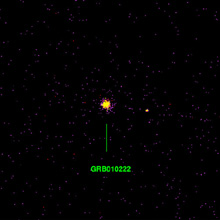April 4, 2001
CXC PR: 01-05
New findings from two X-ray satellites suggest that gamma-ray bursts, some of the most intense blasts in the universe, may be created in the same area where stars are born.
Dr. Luigi Piro of the Consiglio Nazionale delle Ricerche (CNR) in Rome, Italy, presented data from NASA's Chandra X-ray Observatory and the Italian-Dutch ASI BeppoSAX observatory today at the Gamma Ray 2001 conference in Baltimore, MD.
"We know that when a gamma-ray burst explodes, it produces a blast of material called a fireball, which expands at relativistic speeds like a rapidly inflating bubble," said Piro, who works within CNR's Istituto di Astrofisica Spaziale. "Our team found evidence that the blast wave caused by the fireball brakes against a wall of very dense gas, which we believe is the crowded region where stars form."
Several theories exist about what causes gamma-ray bursts. Among more popular theories are that gamma-ray bursts come from various combinations of merging neutron stars and black holes, or, from the explosion of massive stars, called hypernovae.
"Because gamma-ray bursts are going off in extremely distant galaxies, it is difficult to 'see' the regions that harbor them," said Piro. "We can only gather circumstantial evidence as to where and how they form."
Piro's observations support the hypernova model. Scientists believe that within dense star-forming regions, the massive star required for a hypernova explosion evolves extremely rapidly. On astronomical time scales, the supermassive star would evolve over the course of only about one million years. Thus, the hypernova explosion may occur in the same stellar environment that originally produced the massive star itself, and perhaps may trigger even more star formation.
The hint that gamma-ray bursts can occur in dense media came during a Chandra observation of an afterglow that occurred on September 26, 2000. Prof. Gordon Garmire of Pennsylvania State University, University Park, PA, found X-ray emission to be greater than that expected by the standard scenario of a fireball in a low-density medium—an important clue that the explosion occurred in a dense region. Next, on February 22, 2001, Piro said that Chandra observations of the burst’s afterglow, one of the brightest bursts ever observed by BeppoSAX, provided evidence of a fireball expanding in a very dense gas.
These recent results supported data from four other gamma-ray bursts observed by BeppoSAX and Chandra (GRB970508, GRB990705, GRB991216, and GRB000214). In these bursts, Piro and his team found evidence indicating that the burst had encountered an extremely dense gas. The properties of this gas suggest that it originated from a very massive progenitor before it exploded as a gamma-ray burst.
A key element in the success of these observations has been the perfect timing and liaison between the two satellites, Chandra and BeppoSAX, according to Piro. Piro is the Mission Scientist for BeppoSAX, the instrument that first detected X-ray afterglows from gamma-ray bursts.
Currently, astronomers are not usually notified about gamma-ray bursts until an hour or so after they occur. These bursts last only for a few milliseconds to about a minute, although their afterglow can linger in X-ray and optical light for days or weeks. The HETE-2 satellite, launched in October 2000, and Swift, scheduled for a 2003 launch, will provide nearly instant notification of bursts in action, providing satellites such as Chandra a better opportunity to study the afterglow phenomenon in depth.
The ACIS X-ray camera was developed for NASA by Penn State and the Massachusetts Institute of Technology. The High Energy Transmission Grating Spectrometer was built by MIT. NASA's Marshall Space Flight Center in Huntsville, AL, manages the Chandra program. TRW, Inc., Redondo Beach, California, is the prime contractor for the spacecraft. The Smithsonian's Chandra X-ray Center controls science and flight operations from Cambridge, MA.
Images associated with this release are available on the World Wide Web at:
MEDIA CONTACTS
Steve Roy
Marshall Space Flight Center, Huntsville, AL
Phone: 256-544-6535
Megan Watzke
Chandra X-ray Observatory Center, CfA, Cambridge, MA
Phone: 617-496-7998



